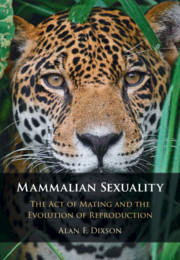Book contents
- Mammalian Sexuality
- Mammalian Sexuality
- Copyright page
- Dedication
- Contents
- Preface
- Acknowledgements
- Part I Carnival of the Animals
- Part II The Act of Mating
- Part III The Evolution of Reproduction
- 5 Phallic Structure and Function
- 6 The Testes and Spermatozoa
- 7 The Accessory Reproductive Glands and Ducts
- 8 Cooperation, Conflict and Cryptic Female Choice
- 9 The Evolution of Mating-induced and Spontaneous Ovulation
- Part IV Epilogue
- Book part
- References
- Index
8 - Cooperation, Conflict and Cryptic Female Choice
from Part III - The Evolution of Reproduction
Published online by Cambridge University Press: 20 May 2021
- Mammalian Sexuality
- Mammalian Sexuality
- Copyright page
- Dedication
- Contents
- Preface
- Acknowledgements
- Part I Carnival of the Animals
- Part II The Act of Mating
- Part III The Evolution of Reproduction
- 5 Phallic Structure and Function
- 6 The Testes and Spermatozoa
- 7 The Accessory Reproductive Glands and Ducts
- 8 Cooperation, Conflict and Cryptic Female Choice
- 9 The Evolution of Mating-induced and Spontaneous Ovulation
- Part IV Epilogue
- Book part
- References
- Index
Summary
Ronald Hunter (1995) summarized the many hazards that mammalian spermatozoa encounter during their passage through the female reproductive tract (Figure 8.1). Most of the sperm perish, being engulfed by an army of leucocytes, or entrapped by mucus, so that they advance no further than the cervix, uterus or uterotubal junction. Some of them fail to undergo physiological changes, triggered by the female’s physiology, that are essential if they are to fertilize ova (e.g. capacitation, hyperactivation of sperm motility and the acrosome reaction). Hence, only a small fraction of male gametes that enter the female tract will reach her oviducts and, of these, only one will unite with each ovum to bring about fertilization (Table 8.1).
- Type
- Chapter
- Information
- Mammalian SexualityThe Act of Mating and the Evolution of Reproduction, pp. 205 - 247Publisher: Cambridge University PressPrint publication year: 2021

